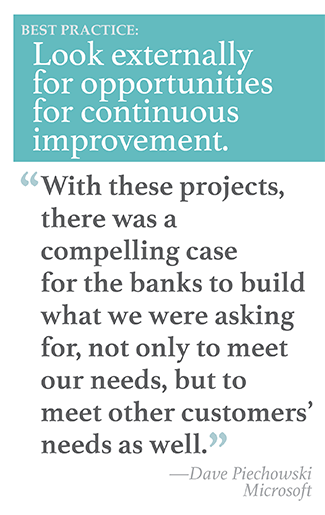
Treasury innovation is a point of pride at Microsoft. The centralized treasury group serves more than 450 subsidiaries in 118 countries around the world, managing over 1,300 bank accounts distributed among 85 different banks. Not surprisingly, cash visibility is a perpetual challenge. In the past decade, Microsoft treasury has pushed to achieve greater visibility into bank accounts and subsidiaries' investments.
"We have a very good idea of what and where our balances are," explains senior treasury manager Dave Piechowski, "but unlike a lot of large treasuries, we don't maintain a single companywide treasury management system. We've built our own Cash Forecasting & Analytics Reporting [CFAR] solution. And one of the things we've been working on, companywide, is maximizing the amount of information that feeds directly from our banks into our ERP [enterprise resource planning] and CFAR systems."
To that end, Microsoft obtained its own SWIFT Bank Identifier Code (BIC). This enabled many banks to automatically feed statements into CFAR. "We pushed our banking partners to provide daily statements in MT940, if not XML, format so that our system could pull in rich account data," Piechowski says. The goal was to be able to analyze trends in cash flow and collections. "You can get a lot more granular when you have the full swath of data," he adds.
Despite these advancements in automating data flows, Microsoft still faced challenges in some of the restricted markets where it does business. Key among these was China. "The system that our banks in China were using to report on our investments didn't work well," Piechowski says. "We couldn't get aggregate data on all our balances via the MT statement through SWIFT. In terms of direct electronic reporting, we were probably getting one-twentieth of the full picture of our cash in-country because our bank balances were reporting but not our investments. As a short-term solution, we achieved visibility to our cash in China by leveraging standard Excel spreadsheets, which was very inefficient."
In Korea and South Africa, Microsoft was using time-deposit accounts to increase incremental yields, but visibility was a problem in those markets as well. "Whenever we would make a time deposit, it would drop off our electronic reporting," Piechowski says. "The money would come back into our demand account when it would get refunded. But our cash position would look very different when an investment went out vs. when it came back in. So automated reporting was not giving us a consistent picture of what the global cash looked like."
The treasury group needed to improve the global accuracy of the data within CFAR. "Our treasurer expects to be able to pull up cash balances, at any point in time, on his phone," Piechowski says. "Not including time deposits from some of our key markets was a big challenge."
He and his colleagues launched an initiative to extend the company's automated reporting process to cover all cash, including both demand deposit accounts (DDAs) and short-term time deposits, in every market where Microsoft does business. Over the course of a year, they evaluated the local reporting capabilities of dozens of financial institutions in more than 75 restricted markets. "We quickly learned that a bank's global capability, reporting options, investment types, and processes are significantly different in emerging markets than in developed markets like the U.S., U.K., and Singapore," Piechowski says.
 To address visibility in China, the team partnered with the Bank of China, Microsoft China's financial controllers, and internal engineering groups to modify standard MT940 reporting. The objective was to enable the bank to deliver a single file each day that contained aggregated data on all the company's in-country time deposit accounts. It was the first solution to consolidate reporting on multiple time deposits in a single SWIFT statement.
To address visibility in China, the team partnered with the Bank of China, Microsoft China's financial controllers, and internal engineering groups to modify standard MT940 reporting. The objective was to enable the bank to deliver a single file each day that contained aggregated data on all the company's in-country time deposit accounts. It was the first solution to consolidate reporting on multiple time deposits in a single SWIFT statement.
"We needed our banks to add up all our bank balances and time deposits," Piechowski says. "It sounds simple, but it was actually incredibly complicated on a systemic basis. Our engineering team identified the specific field formats that we needed in order to see our data properly within CFAR. We worked with the Bank of China at the corporate level to get management's buy-in. Then our engineers worked with their engineers to build, deploy, test, and monitor the solution."
For the other markets in the project's scope, Microsoft weighed different banking options. The team discovered that Citi was launching new deposit products, including money market deposit accounts (MMDAs) in Korea and high-yield demand deposit accounts (HYDDAs) in South Africa. These products offer the improved local yield Microsoft was looking for, but without a reduction in visibility.
Now, bank statement information for accounts in each of these markets flows into CFAR, so cash flows are immediately accessible to Microsoft's treasury executives. In fact, Piechowski says, the CFAR tool now provides visibility into 99 percent of the company's global cash. "That enables faster decisions because treasury leadership is not waiting for lagged bank data for planning," he says. "We see critical information as events are happening. Whether that is something like the Brexit vote, protests in Hong Kong, or a natural disaster in Puerto Rico, treasury and the broader finance team can see—within seconds—how much cash we have in those locations, which helps us understand our risk and our options available to mitigate that risk."
See also
- Partnership Breeds Innovation in Funds Transfers out of India
- Streamlined Repatriation of Cash Around the World
One more benefit of Piechowski's initiative is that it supported an account rationalization project through which Microsoft closed hundreds of accounts and ended more than 30 banking relationships. "In the past, to improve yield, we had buckets of 30-day or 60-day time deposits that rolled over regularly," Piechowski says. "We found the yields on time-deposit accounts in some countries' government-sponsored banks to be too compelling to pass up. But because our cash-visibility initiative significantly improved yield with our core partners on our cash accounts in those markets, we eliminated the need for the one-off time deposit accounts, which eliminated a lot of the account churn and noise that treasury had to deal with in the past."
Although he acknowledges that Microsoft's size gives it more leverage in some markets than smaller companies have, he thinks many banks are willing to work with customers to develop new solutions. "Normally, I'm not sure most treasury practitioners think of continuous improvement as extending beyond their own walls," he says. "But Bank of China and Citibank aren't the only banks that are capable of pushing themselves to get better."
The key to convincing them to do so, he says, is to look at potential change from the bank's perspective. "With these projects," he says, "there was a compelling case for the banks to build what we were asking for, not only to meet our needs, but to meet other customers' needs as well. I think if they're building something new for us, we're serving as a prototype, but if it's successful, they will eventually deploy it with other customers as well."
© Touchpoint Markets, All Rights Reserved. Request academic re-use from www.copyright.com. All other uses, submit a request to [email protected]. For more inforrmation visit Asset & Logo Licensing.


